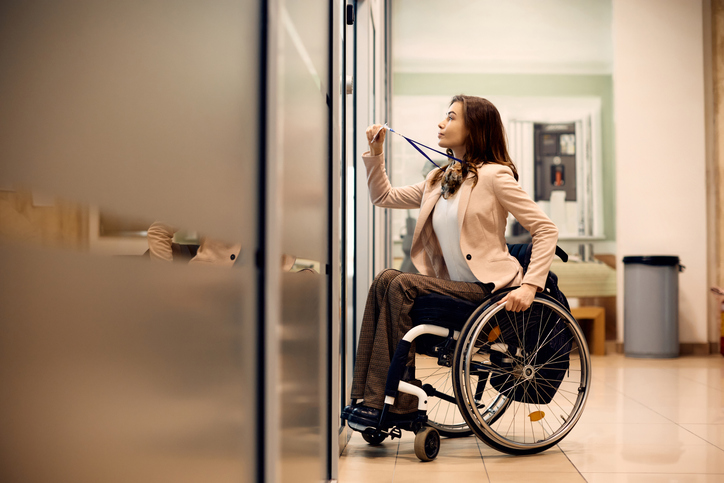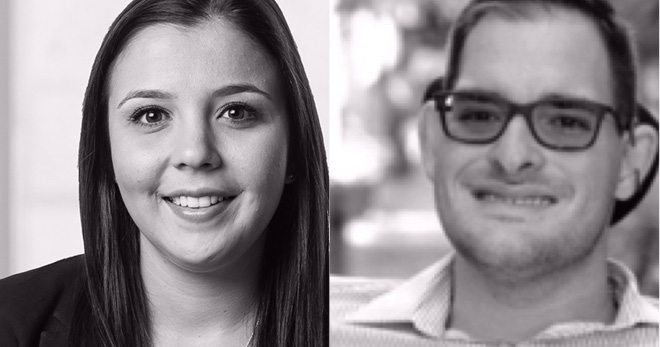A diverse and inclusive legal profession must, alongside diversity of race, sex, ethnicity, gender identity, age and sexual orientation, account for diversity of ability, as more and more people with disability engage with the law as practitioners and clients alike. With this in mind, on 9 November 2022 NSW Young Lawyers and the Disabled Australian Lawyers Association hosted a roundtable discussion focused on the experience of practitioners with a disability in the legal industry.
The panel, made up of Valerie Heath (Barrister, Maurice Byers Chambers), Anna Nguyen (Solicitor, Australian Centre for Disability Law), Carla Viglino (Senior Advisor – People & Culture, Russell Kennedy Lawyers) and Joseph Popov (Disability Student Representative, University of Newcastle Law Students Association), offered an array of valuable perspectives that ought to inform best practice in our profession’s ongoing employment of people with disability.
“There just has not been a real recognition that practitioners can and do practice law with a disability, whether you come with a disability when you start as a practitioner, or whether you acquire a temporary or permanent disability while you are already in practice.”
These are the words of Valerie Heath, a barrister from Maurice Byers Chambers and one of a panel of speakers offering an array of valuable perspectives that ought to inform best practice in our profession’s ongoing employment of people with disability: Anna Nguyen (Solicitor, Australian Centre for Disability Law), Carla Viglino (Senior Advisor – People & Culture, Russell Kennedy Lawyers) and Joseph Popov (Disability Student Representative, University of Newcastle Law Students Association).
An attitudinal evolution
Both Heath and Popov, in sharing their lived experience of disability, identified the many and varied attitudinal barriers faced by practitioners with disability in dealing with courts, clients, and other practitioners.
With reference to the ‘social model’ of disability, which identifies and seeks to remove structural barriers to the inclusion of people with disability, Heath and Popov spoke to the fact that many issues for practitioners with disability are a product of prejudicial attitudes and misconceptions about disability held by others, rather than any inherent limitation or capacity of the practitioner themselves.
As Heath said, “Disability is not something inherent in a person – it is inherent in a society that creates artificial barriers to the full participation of people with disability.”
Popov, who is in the final year of his studies at the University of Newcastle, shared one such experience in seeking adjustments through an interview process: “I emailed three times, and never got a response … attitudinal issues have been a problem, in my experience”.
Heath, an experienced practitioner at the NSW Bar and a member of the NSW Bar Accessibility Panel, spoke to the importance of practitioners being equipped to confidently engage disabled barristers: “briefers and internal managers should have those conversations, to make them more aware and more comfortable with briefing barristers with a disability.”
Heather also observed, “Having a disability makes you a great battle planner, and makes you very aware of the minutiae of steps … the detail focus that many people with disability require just to make it through the day is something that is such an advantage as a barrister.”
“Having a disability makes you a great battle planner, and makes you very aware of the minutiae of steps … the detail focus that many people with disability require just to make it through the day is something that is such an advantage as a barrister.”
Beyond interpersonal attitudinal barriers, prejudicial attitudes towards practitioners with disability manifest themselves systemically, including by way of the near-complete absence of part-time positions available for entry-level and junior lawyers. Nguyen reinforced this: “One of the main challenges facing younger practitioners with a disability is the lack of part-time positions available. Clerkships and graduate programs are competitive enough, and then to expect successful applicants to attend full-time, five days a week … a lot of people with disability just aren’t able to commit to that.”
As Popov observed, “I think the notion of full-time needs to be re-evaluated … people with my type of disability, cerebral palsy, experience fatigue at five times the rate of a person without disability, so while a lot of jobs can now be taken on with a degree of flexibility, thanks to COVID, we still have a long way to go.”
Part of this attitudinal shift, Heath explained, is introspective, and requires an examination of internalised ableism. Practitioners need to also be comfortable with recognising and accepting that they have a disability: “There is work to be done with being okay with saying that you have a disability, and that you need the legal community to make a small adjustment to cater for that.”
Reasonable adjustments and disclosure
The ability to seek and receive these “reasonable adjustments”, as safeguarded by the Disability Discrimination Act 1992, is an important – and practical – means of ensuring the equitable inclusion of people with disability in the legal workforce.
A person’s entitlement to adjustments – and the scope of what is ‘reasonable’ – is an important consideration for employees and employers alike. Nguyen, whose work with the Australian Centre for Disability Law includes advising clients with disability on their entitlements to adjustments, explained that an adjustment is only unreasonable if it would cause an employer “unjustifiable hardship” and that, especially where a request for adjustments is supported by medical evidence, this is a high bar for employers to meet.
Nguyen said, “In most cases, adjustments to equipment or technology are quite easy to make, and it will be difficult for an employer to say that they cannot make those kinds of adjustments … if they say no without providing a legitimate reason, that is disability discrimination.”
“In most cases, adjustments to equipment or technology are quite easy to make, and it will be difficult for an employer to say that they cannot make those kinds of adjustments … if they say no without providing a legitimate reason, that is disability discrimination.”
Both Ms Heath and Mr Popov have sought adjustments in the course of their work, from changes to court timetabling, to designated parking, to adjustable-height tables.
As panellist Viglino said, “Adjustments aren’t an issue. They typically aren’t something massive for an organisation to implement – it is just a standard business practice for us, and we are trying to normalise it across all of our communications.”
Heath concurred: “The more occasions on which barristers and solicitors ask for reasonable adjustments from the Court, the more other practitioners will feel encouraged and safe to do so.”
Even where an employee requires a more significant adjustment, best practice employers can – and should – make accommodations, with an “individual approach”, tailored to suit both the organisation and the employee: the ultimate goal.
A necessary prerequisite to reasonable adjustments, disclosure, was another key theme of the panel discussion. Importantly, Nguyen noted: “You do not have to disclose – however, if you are seeking adjustments, it is reasonable for your employer to know the nature of your disability, so as to ensure that your adjustments are reasonable and realistic.”
In NSW, disclosure is limited amongst both barristers and solicitors, with few effective mechanisms in place for safe, comprehensive and confidential disclosure.
Popov observed, “In my experience, I definitely don’t disclose unless there is a public-facing culture of disclosure within an organisation … in many cases, if that culture isn’t obvious, I won’t apply for fear of being knocked back.”
But opportunities for disclosure are limited, as Heath remarked: “Looking at the Bar, there is no particular opportunity for disclosure, even in terms of measuring the percentage of practitioners at the Bar who identify as people with disability.”
Heath explained that, for practitioners with visible disabilities, disclosure is unavoidable: “Some days I can stand [up] for my advocacy as a barrister, and some days I can’t. So that forces me to make some disclosure”. This may account for lower rates of disclosure amongst practitioners with so-called “invisible disabilities” which Viglino identified as a pressing issue, even at leading disability employer, Russell Kennedy Lawyers.

“I definitely don’t disclose unless there is a public-facing culture of disclosure within an organisation … in many cases, if that culture isn’t obvious, I won’t apply for fear of being knocked back.”
Physical accessibility
Often the most obvious barrier to participation for people with disability is that the physical environment of our public and private legal spaces remains inaccessible. From the absence of accessible bathrooms in practitioners’ offices to a lack of safe drop-off spaces for wheelchair users at public institutions like state and federal courts, it is immediately apparent that – even in 2022 – people with disability are non-standard users of our legal system.
Popov said, “I was invited to an interview with an organisation that said, on its website, that its office was accessible … the office was on the first level of the building, there was no electric door, no intercom system, a small lift, and another door to get into the office … it was a difficult experience to even get to the interview room.”
Heath noted the missed opportunities physical barriers present: “For someone coming to our floor who needed an accessible bathroom, they would need to travel to another floor – it has meant that our floor lost the opportunity to have a wonderful barrister who might use a wheelchair, for example, because of the lack of accessibility.”
Key takeaways: best practice for employers, briefers, and everyone in between
Provide flexibility for seasonal clerks, graduates, and junior lawyers
At the entry point to a career in the law, it’s important that law students and junior practitioners with disability are not excluded by a one-size-fits-all expectation around working times and conditions.
Offer disability-specific recruitment streams
As well as ensuring that your standard recruitment processes are accessible, a disability-specific recruitment stream can be an effective means of creating a diverse and inclusive workforce.
Ensure regular and proactive opportunities for disclosure and the seeking of adjustments
Rather than providing a single opportunity to disclose and seek adjustments at the point of recruitment or offer, proactively offer employees the opportunity to disclose and/or seek adjustments throughout the course of their employment.
Offer diversity and inclusion training (including disability awareness training) at all levels of your organisation
In order to create a culture where employees feel comfortable to disclose and seek support for their disability, ensure that diversity and inclusion training (including disability awareness training) is provided to all levels of the organisation, including upper management.
Diversify your briefing program
Practise allyship by briefing barristers with disability. This not only ensures that people with disability will continue to be represented at the Bar, but also demonstrates a commitment to inclusivity that may encourage employees with disability to disclose and seek adjustments.






